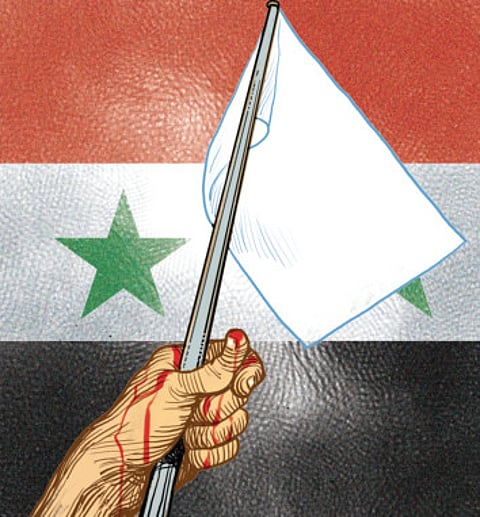Why the Homs truce matters for Syria
Such deals can spare the lives of hundreds of thousands of civilians

As hundreds of Syrian rebels on Wednesday left bastions in Homs, there was hope for provisional political deals in various regions of the war-torn country that offered an alternative to the Geneva 2 process, which evidently failed. The Homs truce will not be the first of its kind between the Bashar Al Assad regime and the rebels. Similar agreements had been reached in other besieged towns, where anti-regime fighters were allowed to leave in exchange for delivering humanitarian aid to the civilian population.
Search for a diplomatic breakthrough between the regime and the Syrian National Coalition (SNC) has been doomed from the start. Former intermediary Kofi Annan gave up long time ago, and his successor, Lakhdar Brahimi, is contemplating walking away from a futile process. The regime is adamant and it has stuck to the military option in what has become a regional power struggle over Syria. Al Assad relies on political and military support from Russia and Iran and he has successfully defended the capital while his army made important breakthroughs in the Qalamoun mountain range, the outskirts of the capital and in the outer regions of Homs, Hama and Aleppo.
Still the Free Syrian Army (FSA) and other groups have made headway in areas north of Latakia, Dara’a, Al Qunaitra and Aleppo’s countryside. Al Qaida-linked Jabhat Al Nusra and the Islamic State of Iraq and Al Sham (Isis) are fighting it out in Deir Al Zour and north of Aleppo. The FSA is in control of most of Dara’a where a southern front is reportedly being assembled. With both US and Russia at loggerheads over Ukraine, the situation in Syria is not about to change anytime soon. The rebels are fighting elite members of Hezbollah, in addition to trained fighters from Iraq under the supervision of Iranian commanders.
However, in spite of the regime’s important gains recently, it is inconceivable that its troops can make a decisive victory. This is the reality in Syria today. The so-called moderate rebels have recently had access to anti-tank missiles that caused major damage to the regime’s offensive hardware. The rebels still await strategic weapons such as anti-aircraft missiles, but there are no indications that the Americans will allow that to happen.
Meanwhile, the regime insists that it will be able to defeat what it calls “terrorist” infiltrations. It has won important political battles recently as European countries expressed concern about the fact that hundreds of their nationals are now fighting in Syria. Al Assad, who is getting ready to win a third term in office, has always claimed that he was fighting radical Islamist forces that pose a threat to the West.
Since the failure of Geneva 2, international attention towards the Syrian crisis has waned. The US administration is still hesitant about adopting a new line on Syria. This could change as the head of the SNC, Ahmad Al Jarba, heads to Washington this week on a crucial visit. His mission is to convince American leaders to supply the FSA with sophisticated weapons. Even if he gets what he wants, it is unlikely that the rebels will be able to change the current balance of power.
In the absence of a political way out and in light of the regime’s insistence on the military option, the Homs truce opens new possibilities. The importance of the truce is that it takes place directly between the government and the rebels on the ground. Each party has an interest in making these truces succeed. It is true that both sides distrust each other and that these lulls in war are usually short-term and can collapse any moment. Yet, they remain the only viable route to achieve a ceasefire and allow humanitarian aid to flow. Furthermore, such deals could actually spare the lives of hundreds of thousands of civilians in besieged cities, while allowing the regime to take over. The rebels get to relocate to strategic areas under their full control like Idlib and parts of Aleppo.
In addition, the rebels get to reinforce their presence in areas where government troops have left. One of those regions is Dara’a where the FSA is in control along with Jabhat Al Nusra. The regime has chosen not to send troops to this region, for now. Al Qunaitra is another strategic area where government forces were forced to withdraw.
The regime is looking to liberate the main cities, like Homs, Hama and Aleppo, for the time being. It has made some gains in the countryside of Damascus. The capital has been secured at the moment and it is in touch with most of the coastal areas. The next big battles will centre on Kassab and Aleppo. The fact that both sides are reaching understandings in the field means that each is adopting a new strategy. These strategies will not end the war, which will go on for few more years, but they can create a situation where each side will accept the presence of the other in certain regions. Unfortunately, this sets the scene for a de facto partition of Syria.
Osama Al Sharif is a journalist and political commentator based in Amman.
Sign up for the Daily Briefing
Get the latest news and updates straight to your inbox



